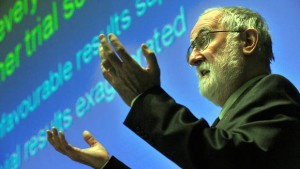David Sackett, “Father” of Evidence-Based Medicine

David Sackett, MD, OC, FRSC, MSc, FRCP, clinical epidemiologist, and founding Chair of the Cochrane Collaboration, has died.
In 1967, Dr. Sackett founded the world’s first department of Clinical Epidemiology and Biostatistics, at McMaster University in Ontario. He founded and was director of the Oxford Centre for Evidence-Based Medicine as well as founding co-editor of the journal Evidence-Based Medicine.
His seminal article in the British Medical Journal (Sackett DL, Rosenberg WM, Gray JA, et. al. Evidence based medicine: what it is and what it isn’t. BMJ. 1996 Jan 13;312(7023):71-2.) defined EBM as,
…the conscientious, explicit, and judicious use of current best evidence in making decisions about the care of individual patients. The practice of evidence based medicine means integrating individual clinical expertise with the best available external clinical evidence from systematic research.
Dr. Sackett wrote over 300 articles, eight books, and dozens of book chapters. A selected few are below.
Articles (open access)
Sackett DL. Six pairs of things to celebrate on International Clinical Trials Day. Trials. 2013 May 20;14:128.
Sackett DL, Oxman AD. HARLOT plc: an amalgamation of the world’s two oldest professions (How to Achieve positive Results without actually Lying to Overcome the Truth). BMJ. 2003 Dec 20;327(7429):1442-5. Includes the tongue-in-cheek “Johnny Mercer strategy for reporting indeterminate trials.”*
Sackett DL. The arrogance of preventive medicine. CMAJ. 2002 Aug 20;167(4):363-4.
Sackett DL, Haynes RB. The architecture of diagnostic research. BMJ. 2002 Mar 2;324(7336):539-41.
Sackett DL. Equipoise, a term whose time (if it ever came) has surely gone. CMAJ. 2000 Oct 3;163(7):835-6.
Straus SE, Sackett DL. Applying evidence to the individual patient. Ann Oncol. 1999 Jan;10(1):29-32.
Straus SE, Sackett DL. Using research findings in clinical practice. BMJ. 1998 Aug 1;317(7154):339-42.
Sackett DL, Rosenberg WM. The need for evidence-based medicine. J R Soc Med. 1995 Nov;88(11):620-4.
Sackett DL, Cook RJ. Understanding clinical trials. BMJ. 1994 Sep 24;309(6957):755-6.
Guyatt G, Sackett D, Adachi J, et al. A clinician’s guide for conducting randomized trials in individual patients. CMAJ. 1988 Sep 15;139(6):497-503.
Sackett DL. How to read clinical journals. Can Med Assoc J. 1982 Jun 15;126(12):1373.
Sackett DL. Sodium restriction for treatment of hypertension. Can Med Assoc J. 1980 May 24;122(10):1131.
Sackett DL. Screening for early detection of disease: to what purpose? Bull N Y Acad Med. 1975 Jan;51(1):39-52.
Books (at the Georgia State University Library)
Straus, Sharon and Sackett, David Mentorship in Academic Medicine, Somerset, NJ, USA: John Wiley & Sons, Incorporated, 2013. (ebook)
Haynes, R. Brian., David L Sackett, and Workshop/Symposium on Compliance with Therapeutic Regimens (1974 : McMaster University Medical Centre). Compliance With Therapeutic Regimens. Baltimore: Johns Hopkins University Press, 1976.
*We “accentuate the positive” by reporting only favourable subgroup analyses. Moreover, you don’t have to settle for just one paper in just one journal. For no extra charge, we will randomise the sentences in the original article and submit the suitably camouflaged duplicate publication to a second, unsuspecting journal.
We “eliminate the negative” by omitting or burying all unfavourable results where nobody can ever find and report them.
And we definitely “don’t mess with Mr In-Between.” We stay out of the DMZ (disappointing, minimally important zone) by suppressing equivocal results and bothersome confidence intervals.